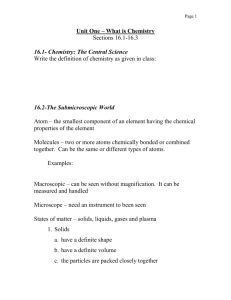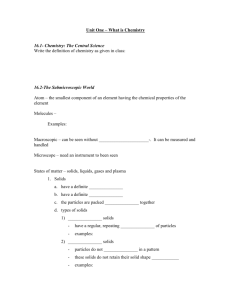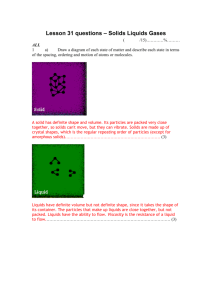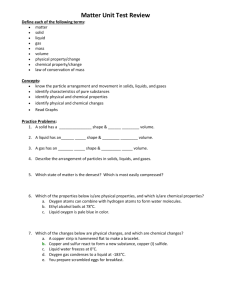Boiling Point = Temperature at which a liquid turns into a gas
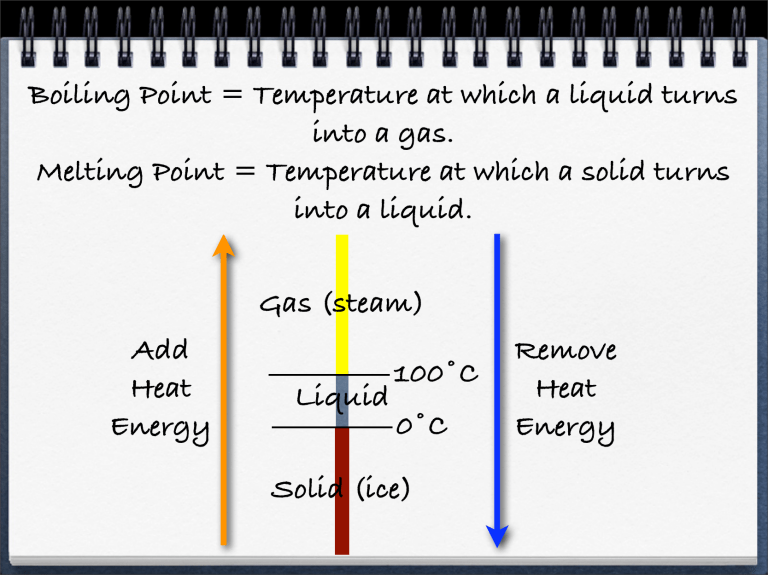
Boiling Point = Temperature at which a liquid turns into a gas.
Melting Point = Temperature at which a solid turns into a liquid.
Add
Heat
Energy
Gas (steam)
Liquid
100˚C
0˚C
Solid (ice)
Remove
Heat
Energy
Physical changes in matter caused by heat energy.
Solids, Liquids, Gases & Plasma
2004 - Doug Gilliland,
Physical Science @ Sarasota High
Introduction to Phases of Matter
Matter can exist in four phases:
Solid Liquid
Gas
Plasma
Increase in Heat Energy
All About
Solids
The particles in a solid are held together in an orderly fashion with little freedom of motion.
To entirely stop the motion the temperature would have to be reduced to absolute zero = 0 K = -273˚C.
Most solids are composed of atoms arranged in a crystalline lattice -
a repeating network of particles. These particles vibrate back and forth in place
A crystalline lattice is made of unit cells.
A unit cell is composed of the repeating two or more atoms that make up the crystalline lattice.
A unit cell in the above crystalline lattice would be composed of two atoms:
Allotropes of Carbon
Allotropes are two or more forms of the same substance.
Graphite Diamond
Graphite, found in pencil “lead” and synthetic oil, is soft due to weak bonds between hexagon layers of atoms. A diamond, with strong bonds between hexagon patterned carbon atoms, is the hardest substance known to man.
How are diamonds and gold measured?
1 karat gold =
1/24 part gold
1 carat diamond =
mass of 0.20 gram
(1/5 gram)
Hope Diamond originally: 115 carats
Currently: 45.5 carats, the Size of a man’s fist
Snowflakes are a good example of a crystalline solid.
The growing crystalline lattice makes a unique geometric shape - no two flakes are the alike.
Most rocks are composed of crystals.
Crystals of potassium nitrate grow slowly in water as atoms join together to build the crystalline lattice.
Amorphous Solids
While most solids are crystalline, some like clay, asphalt, plastic and wax are amorphous solids.
These solids do not have any order amongst their atoms or molecules.
No set arrangement of particles
Properties of SOLIDS a. Have a definite shape & definite volume b.Vibrating Particles are locked in place in a crystalline lattice.
c. Of the 4 phases, solids have the least amount of heat energy.
All About
Liquids
When a solid is heated to it’s melting point, the crystalline lattice breaks apart - forming a liquid.
Particles are now free to move.
The particles in a liquid not held together in a rigid pattern and can move past one another.
The particles in a liquid are still close together.
This is the reason why both solids and liquids are not compressible but gasses are.
Properties of Liquids a) Have a definite volume but no definite shape.
b) Are usually less dense than solids, but more dense than gases.
c) Have particles that are free to move about.
d) Produced by heating a solid to its m.p.
Solid Liquid
Viscosity of Liquids
Viscosity is the resistance of a liquid to flow.
The more resisitance to flow, the higher the viscosity.
Motor Oils protect an engine from wear and tear due to friction between moving parts.
Motor oils are rated by their viscosity.
A motor oil of 10W-40 means it has a viscosity of 10 (low) in the winter and
40 (high) in the summer.
The higher the temperature inside the engine- the higher the viscosity of the oil required.
What are the bubbles in this water made of ?
a) The bubbles are made of air.
c)The bubbles are made of oxygen.
b)The bubbles are made of hydrogen.
d)The bubbles are made of water vapor.
b)The bubbles are made of hydrogen.
We live in an atmosphere that extends over 200 miles above us.
The weight of this atmosphere exerts a pressure of 15 lbs. of pressure on every square inch of everything on the surface.
200 mi.
55 mi.
30 mi.
12 mi.
When a liquid’s particles gain enough kinetic energy (from heat)
to break through the surface, the liquid begins to boil.
Particles in a liquid cannot escape due to air pressure pushing down on the surface of the liquid.
air pressure air pressure air pressure
What would happen to water at room temperature if you placed it in a vacuum bell jar and pumped out the air?
The boiling point of water decreases from 100˚C to 23˚C.
As air pressure decreases, the boiling point of a liquid decreases.
When a liquid boils it loses heat energy. What would happen if you didn’t replace this heat energy?
As Atmospheric pressure decreases, a liquid’s boiling point decreases.
For each thousand feet above sea level, the boiling point of water drops almost 1°C (1.8°F).
Water boils at:
75°C(167°F)on Mt. Everest
95°C(203°F) in Denver, CO
100°C(212°F)in Sarasota, FL
As air pressure decreases, a liquid’s B.P. Decreases.
Pressure cookers work on the principle that if you increase the pressure above a liquid the boiling point increases.
Raising the boiling point cooks the food faster at a higher temperature.
Some substances like dry ice (frozen CO
2
) have no liquid phase - they go directly from a solid to a gas. The process of going from a solid directly to a gas is called:
SUBLIMATION .
When dry ice sublimes, invisible CO2 gas is produced.
More dense than air, carbon dioxide extinguishes a flame.
There are many liquids other than water.
The only metallic liquid at RT, mercury, has a density of 13.5 g/cc.
A gallon of mercury weighs 108 lbs.
All About
Gases
Unlike solids and liquids, the particles in a gas are far apart and move at an extremely rapid rate.
Another property of gases is that they are compressible. According to Boyle, pressure and volume are inversely proportional.
Gases take up much more space than solids or liquids.
This is proof that particles in a gas are far apart, while those in a solid or liquid are close together.
M.P.
B.P.
CO
2
-79˚C -79˚C
N -209˚C -196˚C
He -272˚C -268˚C
What is the temperature of Liquid N?
Around -200˚C
What would happen if you put helium gas and carbon dioxide gas in liquid nitrogen?
Properties of Gases a) Have no definite volume or shape.
b) Are less dense than solids & liquids.
c) Have particles that are free to move in all directions - hence they take up all available space in a container.
d) Can be easily compressed since the particles are separated by great distances.
Evaporation is a slow process that only takes place at the surface of the liquid.
A few particles only at the surface break free and go into the air.
Particles turn to a gas, rise to the surface & break free.
Boiling is a rapid process in which molecules gain heat energy and go through a phase change to become a gas.
The atmospheric pressure is 14.7 lbs/sq. inch
(1.0 atm or 760 mm of Hg)
Atmospheric pressure can crush a can if the pressure inside the can can be reduced.
Pressure is equal,
No change
Pressure is unequal,
Can crushed
All About Plasma
Plasma is the 4th phase of matter.
Plasma occurs when matter is heated to extremely high temperatures.
Atoms lose electrons & become charged particles. Stars are made of plasma as is lightning. Over 99.9% of the universe is plasma.
Lightning
Atomic & Hydrogen Bomb
All About Phase Changes
Plasma
Gas
Removing heat
Adding heat
Liquid
Solid
During a phase change, there is a change in heat energy but no change in temperature.
At the melting point , heat energy is being used to break down the crytalline lattice.
At the boiling point , heat energy is being used to convert the liquid to a gas.
During a phase change, heat is being used to change phase, not increase the kinetic energy of the particles.
It is for this reason that Temperature remains constant in a phase change while heat energy changes.
Phase Change Graph condensing
GAS boiling
Temp
˚C LIQUID freezing melting
SOLID
The temperature remains constant during a phase change!
Heat energy (calories)
Temp
˚C
F.P and M.P
oxygen -218˚C water 0˚C lead 328˚C salt 801˚C gold 1064˚C sand 1610˚C carbon 3550˚C freezing melting
SOLID
Phase Change Graph
LIQUID condensing boiling
C.P. and B.P.
oxygen -183˚C water 100˚C salt 1413˚C lead 1740˚C sand 2230˚C gold 2807˚C carbon 4827˚C
Heat energy (calories)
GAS
Here are two other ways of looking at phase changes.
Let’s put it all together!
Any pure substance can be changed into a solid, liquid, gas or plasma by adding or removing heat. A phase change is a physical change since you can change matter back to it’s original state.
Solid Liquid Gas




